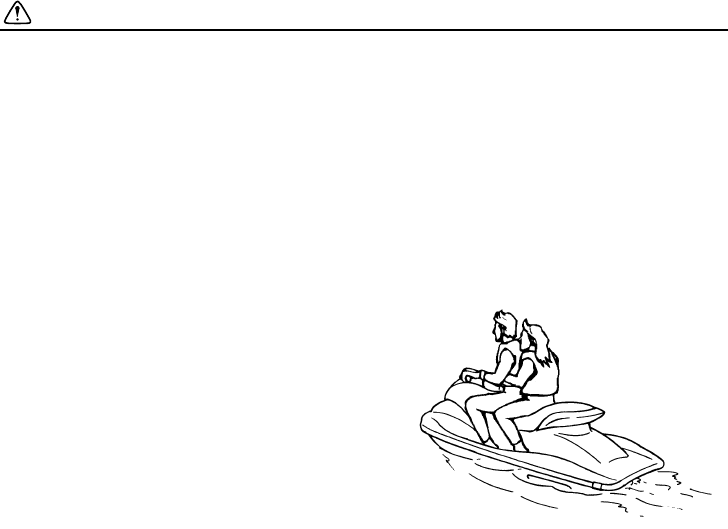
Safety information
13
know that a helmet could help protect you in
certain kinds of accidents and that it could
injure you in others.
A helmet is designed to provide some head
protection. Although helmets cannot protect
against all foreseeable impacts, a helmet
might reduce your injuries in a collision with
a boat or other obstacle.
A helmet may have potential safety haz-
ards, as well. Falling into the water could
risk the chance of the helmet catching wa-
ter, commonly known as “bucketing”, and
the resulting strain on your neck could
cause choking, severe and permanent neck
injuries, or death. A helmet could also in-
crease the risk of an accident if it reduces
your vision or hearing, or if it distracts you or
increases your fatigue.
How should you decide if a helmet’s poten-
tial safety benefits outweigh its potential
risks for you? Consider your particular
riding conditions. Consider factors such as
your riding environment and your riding
style and ability. Also consider the likeli-
hood of traffic congestion, and the water
surface conditions. If you decide to wear a
helmet based upon your riding circum-
stances, choose one carefully. Look for a
helmet designed for personal watercraft
use, if possible. Consider a helmet meeting
Snell or DOT standards. If you will be en-
gaging in closed-course competition, follow
the helmet requirements of the sanctioning
organization.
● Never operate the watercraft after consum-
ing alcohol or taking other drugs.
● For reasons of safety and proper care of the
watercraft, always perform the pre-opera-
tion checks listed on page 48 before operat-
ing the watercraft.
● The operator and passenger should always
keep their feet on the floor of the footwell
when the watercraft is in motion. Lifting your
feet increases the chances of losing your
balance, or hitting objects outside the wa-
tercraft with your feet. Do not give a ride to
a child whose feet cannot reach the floor of
the footwell.
● The passenger should firmly hold on to the
operator.
● Never allow a passenger to ride in front of
the operator.
● Always consult your doctor on whether it is
safe for you to ride this watercraft if you are
pregnant or in poor health.
● Do not attempt to modify this watercraft.
Modifications to your watercraft may reduce
safety and reliability, and render the water-
craft unsafe or illegal for use.
● Attach the engine shut-off cord (lanyard) to
your left wrist and keep it free from the han-
dlebars so that the engine stops if you, the
operator, fall off. After riding, remove the
engine shut-off cord (lanyard) from the wa-
UF2R10E0.book Page 13 Friday, October 31, 2008 9:14 AM


















